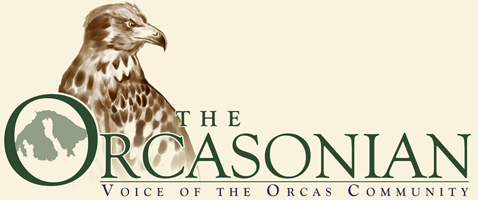— by Margie Doyle —
With OPALCO Board of Director candidates Ed Sutton and incumbent Winnie Adams showing up, the April 9 forum for the four candidates to fill the two board openings on the OPALCO board took some turns from the typical election forum. But the conversation on Thursday night, sponsored by the Islands Energy Coalition, was all to the good as Sutton and Adams spoke up for the Co-op and raised questions in response to audience comments.
Eric Youngren moderated the forum, and opened the evening saying that Islands Energy Coalition was a loosely-knit group, focused solely on raising awareness about energy issues. The group also sponsored a similar meeting on Lopez Island on Tuesday night.
After presenting their own and the absent candidates’ statements (see below), Adams and Sutton responded to thoughtful and complex questions from the group of about 20 in the Public Library Conference Room. Speakers questioned:
- the distinction between electric and broadband services,
- the practices of board/members’ decision-making,
- recent investment in subsidizing Rock Island Communications,
- the atmosphere of trust and transparency in the rural electric cooperative,
- expenses and rate increases,
- the financial health of the organization, and
- communication to the members.
Chief among the questions were concerns about the relationship between OPALCO and Rock Island Communications.
Electricity Coop AND/OR Internet Provider?
Adams noted that in 2002 OPALCO installed conduit for a fiber optic grid, primarily to service electrical customers. There remained unused capacity in that system. OPALCO then began exploring ways to meet co-op members’ need for expanded broadband service. In 2013, they proposed that co-op members “vote” by pledging to pay $75 month for broadband service; every co-op member would pay $15 infrastructure fee to support the expansion. A voluntary member donation program like Project PAL would support members who could not pay the co-op infrastructure fee.
Adams said that she was relieved when, due to lack of member support, that initial plan to expand broadband was dropped. It was “too expensive,” she said. Following the Nov 2013 break, the board decided to expand, “byte by byte.”
Sutton described the expansion of broadband as “the biggest thing we’ll address.” Making broadband internet connectivity a “stand-alone” issue unassociated with electricity is “not dealing with the underlying issues in the power supply,” he said.
OPALCO investment in subsidizing Rock Island Communications
(In February 2015, OPALCO funded the start-up costs and working capital for Rock Island Communications to expand broadband, in the form of a loan. The impact on members is $3 per month for 24 months and is included in the recent rate increase, according to OPALCO’s Suzanne Olson)
Adams said that OPALCO provides the “fiber and physical infrastructure” for internet/broadband, that will be transferred to Rock Island for its broadband customers. “The fiber used for the electric side will be kept by OPALCO,” she said. Some of that conduit is in the county roads’ right-of-way; other conduit must be extended through agreements with homeowners’ associations, most recently the Alder Cottages Homeowners Association along Lovers Lane in Eastsound.
Areas such as West Sound and Rosario may get better access to broadband service if the neighborhoods agree to cooperate on expanding their OPALCO fiber optic network, Adams said.
Loss of trust in OPALCO
Todd Shaner expressed his disappointment that, after he retired from OPALCO after 33 years, he no longer felt it was “our company.” He complained of a lack of transparency, the “challenges that have caused directors to retire.” He asked how long OPALCO had been in negotiations with Rock Island and what had been the cost of the acquisition.
Adams responded that the cost was $500,000, and that negotiations were not publicized as part of a non-disclosure agreement between OPALCO and Rock Island.
Sutton said he feels “OPALCO started to get lost in their communications; there’s a sense of lessened transparency. Someody’s got to take a step back.”
Adams explained that, after the initial plan to expand broadband was dropped, members renewed their request for OPALCO to provide interconnectivity following the November 2013 cable break and interruption of service. In response, the board then decided to expand, “byte by byte,” she says.
“We were in mid-process when Rock Island, with its 2,200 members, wanted to negotiate.” The board decided that it would consider the acquisition only as a subsidiary, modeled after a community program called Fast.Net in Douglas, Oregon.
OPALCO lineman Roger Sandwith said “It’s hard for us as employees and coop members when we can’t answer the public’s questions,” when they are working in the field.
Fred Klein summarized his perception that the root of the loss of trust in the OPALCO board and management was the sequence of members’ rejection of the first sign-up plan for broadband expansion, followed by “the next thing we heard was ‘that train has left the station.'”
Adams reviewed the history, noting that in the CenturyLink cable breakdown of November 2013, co-op members expressed an emergency need for OPALCO to move ahead in expanding its broadband network; and that the board responded by working with local internet service providers (ISPs) such as Rock Island and Orcas Online.
Rate increases
Fred Klein spoke of the power usage and base rate debate, prompted by OPALCO’s decision to increase rates this year, after conducting a cost of service study. Klein said that the Board’s decision “pushed for more in the basic rate, and less in a usage charge” and asked the two candidates present to state their positions, and if they supported a different way of charging.
While Sutton said, “I don’t think the rate structure is the right thing to do,” Adams said that, after the cost of providing electricity, particularly in light of the $15M price tag for early repair of one of the submarine cables, the co-op required a rate increase. Peak demand is the main driver for facility costs, she said.
Klein said, “I consider the base rate grossly unfair. The board should be … more creative to determine the cost of service for peak demand.”
One questioner said that his understanding was that “the higher base rate assures part-time people pay infrastructure costs” and that was the point of increasing the rate. Adams agreed with that assessment. She said that part-time island residents are estimated to be one-third or 40% of
co-op members, according to different statistics.
Todd Shaner said that he is now worried about rate increases next year. “There are too many surprises,” he said. Adams said that, given the concern about the structure of this year’s rate increases, the board “Will have to relook at the structure [of rate increases].”
Board OR Members Making OPALCO Decisions?
David Turnoy returned to the matter of a rural electric company expanding into broadband, and asked, “When does the board decide, and when does the co-op [membership] vote?
Sutton said, “Change is inevitable, but the community rejected broadband. Even if the board wanted to pursue it, it should have been brought up to membership.” He also said he would like the annual meeting to be more informative and discursive and not such “a dog and pony show.”
Adams said that for many in the community, broadband and electricity “go together as power.” She recalled the several meetings where participation was solicited and feedback was invited.
Dennis King asked if OPALCO considered “the ethics of … buying a market competitor and making payments to that competitor.”
When Adams responded that OPALCO is subsidizing Rock Island “for a short period of time,” King asked why the co-op “didn’t go further and become an internet provider” itself, or subsidize all local ISPs.
Roger Sandwith joined in, suggesting that Rock Island become a separate co-op, and Adams replied that she would address that idea with the OPALCO at its next meeting (Thursday, April 16 in Friday Harbor.)
Suzan Chamberlayne suggested that with OPALCO’s rate increase rationale of warmer summers, a February 2014 cold snap and larger-than-anticipated cost of replacing submarine cables, it was “the wrong time to invest in Rock Island.”
Adams said that the agreement with Rock Island was “a way for the community to own the system,” with OPALCO owning the capital infrastructure, and Rock Island providing the interconnectivity expertise. Chamberlayne then suggested that it would be appropriate for OPALCO to consider bids from all internet service providers.
Financial Health of OPALCO
Adams described being shocked when the anticipated cost of replacing the $3M submarine cable came in at $15M. King asked, “What other submarine cables may be decaying faster than anticipated?”
Sutton said that he would expect that an inspection and maintenance schedule was in place; and that part of OPALCO directors’ responsibilities is “Ed planning to anticipate the unanticipated.” He described several facilities breakdowns that he’d had to address as an Eastsound Sewer and Water Commissioner.
Adams said that when Century Link used an underwater camera in addressing the Nov. 2013 cable break, OPALCO took advantage of the opportunity to examine the submarine cable. Permitting and environmental costs are driving the price up, she said.
Jeff Otis asked what they would do to look at budget costs. Adams said, “We need a new business plan, especially if this year is so warm again.”
While Sutton expressed concern for OPALCO’s financial security, particularly its debt/equity ration, Adams said, “The ratio of debt to equity is really sound.” She pointed out that in previous years, OPALCO has had to spend down its equity, but that it is a part of the business ebb and flow.
At the conclusion of the meeting, Shaner thanked Adams in particular for her participation in the forum, and said, “It would be nice if other board members could be here.”
Adams said she too appreciated the discussion: “It gives a sense of the complexity of this simple little co-op.”
Candidates’ Statements
All OPALCO co-op members will vote for the two openings on District 2, which comprises which includes Orcas, Armitage, Big Double, Blakely, Fawn, Little Double and Obstruction islands. Current District 2 directors are Winnie Adams and Chris Thomerson. Challengers are Randy Cornelius and Ed Sutton.
Following are the candidates’ statements as read in the April 9 meeting.
ChrisThomerson said that OPALCO delivers the cleanest energy at the lowest cost. He will ensure that co-op electric members don’t pay for broadband, to oversee financing the dramatic expense for repairing submarine cables, and to improve the electric grid to serve future capabilities.
Randy Cornelius promised reasonable rates and to treat energy efficiency as a power resource. He said that in regard to Rock Island Communications, ” the train has left the station,” and he wants to make sure the fiber optic backbone remains under OPALCO ownership. The co-op’s power bill is based on Bonneville Power Administration (BPA’s) fixed costs, and OPALCO must do a cost of service analysis.
Ed Sutton told the gathering that he preferred to speak extemporaneously in response to questions. He said his university degrees were in business administration and market research. He stressed the importance of participation for those living in a small community: “I hope we all pass along to our kids that you give your share.”
After listing the numerous boards and committees on which he has served, Sutton said, “It is important that directorships rotate on a regular basis” to provide a fresh pair of eyes and new perspective on an organization. He suggested a policy for low-income residents, the need for more money to make the system bigger, and the demands of maintenance for capital investments among the subjects he’d like to see the OPALCO board address.
Winnie Adams described her interest in alternative energy, and said she wanted to serve on the OPALCO board when it came to her attention that the BPA load was exceeding what BPA could provide. As director she helped to start MORE (Member Owned Renewable Energy) “to support the growth of locally generated power, funded by member contributions.”
“Broadband requires us to broaden our view and consideration,” she said. She emphasized that conservation and efficiency are considered resources as well as alternative energy and cited the “incremental growth of solar power.” She also described the number of ways OPALCO is partnering with other organization.
Ballots for the election were mailed this week. For statements of all candidates, consult the voters brochure.
**If you are reading theOrcasonian for free, thank your fellow islanders. If you would like to support theOrcasonian CLICK HERE to set your modestly-priced, voluntary subscription. Otherwise, no worries; we’re happy to share with you.**








Unlike two of the OPALCO board candidates, a small group of interested members, including current and past OPALCO employees, attended the candidates forum last Thursday night. Of the four candidates running for the two open board positions, only Winnie Adams and Ed Sutton were present. It was very unfortunate that Chris Thomerson and Randy Cornelius were absent as there was a spirited and informative discussion initiated by the OPALCO employees regarding the lack of transparency and erosion of trust sparked by the recent purchase of Rock Island. Current Board member Winnie Adams did an admirable job of addressing the issues, though it was clear that she became progressively concerned about OPALCO’s business plan as the discussion evolved. Winnie noted that the negotiations between Rock Island and OPALCO were confidential, apparently requested by the then owner of Rock Island. While it might be understandable that the actually purchase negotiations would be a matter of executive session, it was unclear why OPALCO management decided to pursue purchase of Rock Island without first surveying and informing its member/owners of its intent to do so. After the failed proposal to pursue broadband on its own, OPALCO indicated that it would make its infrastructure available to the local internet service providers such as Rock Island and Orcas Online at a cost. From the discussion at last Thursday’s candidates forum, it was unclear why OPALCO jumped tracks from partnering with local internet service providers to purchasing Rock Island. While it’s too soon to know if the purchase will ultimately benefit the membership, the lack of transparency appears to be signifying a new direction for OPALCO, one in which the management knows best, and its member/owners should just get on board the train.
I totally agree with you Jeff, on all points! Especially the apparent “Sleight of hand” Rock Island Deal. It was shocking to be informed after the deal was made. WE Are STILL A Cooperative! This Board is following in the footsteps of Big Business models. There is a disconnect.
Spirit Eagle
Margie
Thanks for providing this extensive summary of the meeting last week. I was off-island and unable to attend so your article along with feedback from attendees is very helpful as we decide how to cast our OPALCO ballots.
In 1950, at Olga, our phone had a ring of 2 long rings and a short ring, generated by the operator in Eastsound. This was wonderful!!! Then in 1960’s we had a rotary phone, then 1990’s a dial tone… now internet…..all this wonderful change for communication. I love and use it all. During all those same 50 years, a plug was used to light our light bulbs and to make our radio or stove to work. No real change there. My point here is that where would my dollars be now if I had purchased $900,000 of crank phones ? Communications is much too changing for us, the owners of OPALCO to be investing in something that will be obsolete in 10 years. Let OPALCO be our electric Co-op and let the Communication Company stand on their own…totally separate..no loans either.